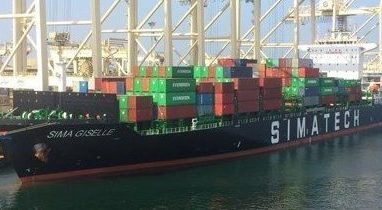The unsung heroes of containerisation

Making his Splash writing debut, Santosh Patil focuses on the little reported world of the feeder trades.
When one pores through the coverage on container shipping, it is not difficult to conclude that there is little or no content available on short sea/ feeder services, its contribution and significance to the shipping industry. While one can see scores of reports, articles, forecasts, expert views and what-have-you on container shipping industry and containerisation in general, information on short sea shipping or containers feeder services is conspicuous by its absence. Therefore, I wish to put forth my perspective on container feeder industry and its contribution to the growth of container shipping.
Container shipping has grown by leaps and bounds in the last few decades and almost every type of cargo that can be unitised has been containerised making it the leading form of cargo transport globally. Thanks to unitisation, the ‘container’ can be seen in almost every corner of the globe and has perhaps the highest visibility amongst all assets used in maritime transport. However, little is known or appreciated of the crucial role played by container feeder industry in this highly ‘visible’ means of transport.
Container feeders play a vital role of being the first or last mile (many a times both) in the journey of a shipping container. Feedering significantly contributes to the development of a new port and it is most often that a feeder vessel which is amongst the first vessels to make a port call. The all-important connectivity to small ports with hub ports is only possible through feeders.
Primarily, container feeders are of two types – ‘common carrier feeder’ and ‘dedicated feeder’ with the common carrier feeder being an independent operator who is free to accept containers from several different MLOs on a given route. The ‘dedicated feeder’ usually is an exclusive arrangement with an MLO (or its associate companies) operated either by a feeder operator or by the MLO itself. Some main lines have a separate division or entity which operates dedicated feeder vessels to exclusively cater to its own feedering requirements.
Feedering plays a vital role in driving efficiencies and provides considerable value to the main line operators who can provide a wider bouquet of ports to their customers without deploying its assets. Although there is a synergistic relationship between MLOs and a container feeder operator, it is often the MLOs network which defines the service route of a feeder operator. The business model of a container feeder operator is therefore highly dependent on mainline services.
A feeder service helps the MLO to provide services to & from ports which hitherto were not accessible for various reasons like draft, parcel size (volume of cargo), availability of a suitable vessel, seasonality of cargo, port costs amongst others. Container feeders therefore bring immense value to the maritime supply chain. Despite this, the survival of a feeder operator is difficult unless it exhibits the deftness, flexibility and willingness to take bold decisions.
However, it is always the bigger mainline liner operators (MLOs) who have hogged the limelight (and perhaps rightfully so), while the smaller but key cogs in the wheel – the container feeder operators – remain unseen and often do not get recognition they deserve, leave a small mention here or there. Mainstream shipping media too has not covered feeder operators as they perhaps should.
The current fleet scenario in an increasingly oligopolistic liner market has seen preference towards ultra large container vessels (ULCVs) for achieving efficiencies of scale. While the jury is still out on whether this will truly translate to tangible benefits, it certainly provides an opportunity for feeder operators. The ULCVs will not be able to provide the reach in terms of port coverage given the restrictions in draft, port costs, and infrastructure requirements to handle ships of such size.
With the size of mainline ships growing, feeder ships too are sizing up. The Panama Canal expansion led to availability of a flurry of panamaxes at attractive valuations. This led to the snapping up of panamaxes by common carrier feeder operators like Xpress Feeders, Transworld Feeders (formerly known as Orient Express Lines), Simatech, Milaha and several others.
Despite the spate of M&A activity, which some industry sources believe will continue, one can say with a bit of certainty that feedering is here to stay at least for the foreseeable future.

Such a nice article on feedering, although I do no necessarily agree upon everything being written. What is absolutely true is the fact that there is very little coverage of the feeder industry among the rich container shipping literature. This despite the fact that an estimated worldwide 65 million TEU were feedered last year. Last month, Dynamar of The Netherlands published its third report on the subject of “Transhipment and Feedering”.
Hi Dirk. It would be great to get a summary write-up of some core KPIs in feeder market. REV/TEU. vessel efficiency. SOC vs non SOC…thks and best!
Funny that the unseen feeder industry is described at length but that the author on his turn seems to be blind to the important complementing world of inland waterway container trade as it is not mentioned anywhere in the article.
Welcome, and thanks for an interesting article Santosh!
I guess Ferry van Eeuwen has just tee-d up your next article!
Thanks for this article and expect further more.